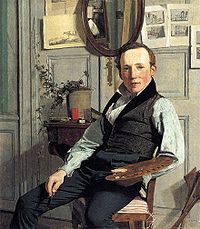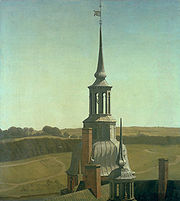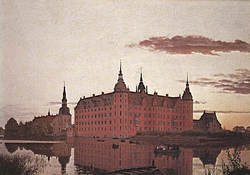
Christen Købke
Encyclopedia
Christen Schiellerup Købke (26 May 1810 – 7 February 1848), Danish
painter, was born in Copenhagen
to Peter Berendt Købke, a baker, and his wife Cecilie Margrete. He was one of 11 children. Købke is one of the best known artists belonging to the Golden Age of Danish Painting
.
to Kastellet
, a military fortification area in Copenhagen, where his father was head baker. At the age of 11 he suffered from a bout of rheumatic fever
. He made many drawings during his convalescence and decided that he would become an artist.
In 1822 at 12 years of age he started his studies at Royal Danish Academy of Art
(Det Kongelige Danske Kunstakademi). He studied first in the drawing class, then under C. A. Lorentzen’s painting studio, and finally 4 years under Christoffer Wilhelm Eckersberg
after Lorentzen’s death in 1828. Eckersberg stressed observance of nature, and Købke’s talent grew under Eckersberg’s disciplined training. Eckersberg’s influence is readily seen in Købke’s first mature work "View of Århus Cathedral" (Parti af Århus Domkirke) painted in 1829. The painting was purchased by the Art Union (Kunstforening) and is now in the collection of the National Art Museum (Statens Museum for Kunst).
He received the Academy’s small silver medallion in 1831 and a large silver medallion in 1833.
 He lived in Kastellet
He lived in Kastellet
until 1833 and made many paintings of the area. His painting "Gården ved bageriet i Kastellet" (ca. 1832) hangs in the Ny Carlsberg Glyptotek
museum in Copenhagen.
In 1832 he shared a studio with friend, landscape painter Frederik Hansen Sødring. He painted a portrait of Sødring which now hangs in the Hirschsprung Collection
.
In 1834 he moved, along with his parents, outside of Copenhagen’s fortifications near Sortedamssøen, a lake area. He painted many views overlooking the lake towards the city and the embankments surrounding the city. His work becomes larger, more monumental.
Like many of his contemporary artists he came under the influence of Niels Lauritz Høyen
, art historian, who promoted a nationalistic art. Høyen called for artists to search for subject matter in the folk life of their country instead of searching for themes in other lands, such as Italy (which was at that time considered a requirement for an artist’s training). On a visit to Hillerød
in 1835 he painted a romantic picture of Frederiksborg Palace
, "Frederiksborg Slot ved Aftenbelysning" ("Frederiksborg Palace in the Evening Light").
At the end of 1837 he married Susanna Cecilie Købke (1810–1849), and shortly afterwards painted a portrait of his young bride.
 In 1838 he received a travel stipend from the Academy, left his new wife and traveled over Dresden and Munich to Italy accompanied by decorative painter Georg Hilker
In 1838 he received a travel stipend from the Academy, left his new wife and traveled over Dresden and Munich to Italy accompanied by decorative painter Georg Hilker
. They arrived in Rome by year’s end where he met brother-in-law Frederik Christopher Krohn, sculptor and medallionist, and many other Danish artists. He traveled, along with Constantin Hansen
the following summer to Naples, Sorrento, Pompeii and Capri where he painted out in the open air.
.
Two years after his father died in 1843 the family sold the property outside Copenhagen, and Købke moved back into the city. His application for admission to the Academy, which was accompanied by one of his failed Italian landscapes, was rejected in 1846. He died in 1848 of pneumonia
, and is buried in Assistens Kirkegård.
 Købke, a national romantic
Købke, a national romantic
, painted portrait
s, landscape
s and architectural
paintings. Most of Købke’s portraits show friends, family members and fellow artists. He found most of his motifs
in his immediate surroundings. Now he is recognized internationally for his well composed and harmonic paintings, for their coloristic qualities and for his sense of the everyday life. But in his lifetime he was almost forgotten, especially because of his early death and limited production. Despite his talent and the praise of various contemporaries, Købke had never been inundated with commissions.
Købke is recognized today as one of the most talented among Denmark’s Golden Age painters and the most internationally renowned Danish painter of his generation. The painterly interpretations he made of his surroundings stand as highpoints of the period.
His works are in the collections of not only Danish museums but also such international museums as the J. Paul Getty Museum
http://www.getty.edu/art/gettyguide/artMakerDetails?maker=793.
Denmark
Denmark is a Scandinavian country in Northern Europe. The countries of Denmark and Greenland, as well as the Faroe Islands, constitute the Kingdom of Denmark . It is the southernmost of the Nordic countries, southwest of Sweden and south of Norway, and bordered to the south by Germany. Denmark...
painter, was born in Copenhagen
Copenhagen
Copenhagen is the capital and largest city of Denmark, with an urban population of 1,199,224 and a metropolitan population of 1,930,260 . With the completion of the transnational Øresund Bridge in 2000, Copenhagen has become the centre of the increasingly integrating Øresund Region...
to Peter Berendt Købke, a baker, and his wife Cecilie Margrete. He was one of 11 children. Købke is one of the best known artists belonging to the Golden Age of Danish Painting
Golden Age of Danish Painting
The Danish Golden Age covers the period of creative production in Denmark, especially during the first half of the 19th century. Although Copenhagen had suffered from fires, bombardment and national bankruptcy, the arts took on a new period of creativity catalysed by Romanticism from Germany...
.
Childhood and early training
In 1815 the family moved from a bakery near HillerødHillerød
Hillerød Kommune is a municipality in Region Hovedstaden . The municipality covers an area of 191 km² , and has a total population of 46,568...
to Kastellet
Kastellet, Copenhagen
Kastellet, located in Copenhagen, Denmark is one of the best preserved fortifications in Northern Europe. It is constructed in the form of a pentagram with bastions at its corners...
, a military fortification area in Copenhagen, where his father was head baker. At the age of 11 he suffered from a bout of rheumatic fever
Rheumatic fever
Rheumatic fever is an inflammatory disease that occurs following a Streptococcus pyogenes infection, such as strep throat or scarlet fever. Believed to be caused by antibody cross-reactivity that can involve the heart, joints, skin, and brain, the illness typically develops two to three weeks after...
. He made many drawings during his convalescence and decided that he would become an artist.
In 1822 at 12 years of age he started his studies at Royal Danish Academy of Art
Royal Danish Academy of Art
The Royal Danish Academy of Fine Arts has provided a practice-oriented complement to the scholarly investigation of the arts carried out at Danish universities for more than 250 years, playing a crucial part in the development of the distinctive tradition of the art of Denmark.- History :The Royal...
(Det Kongelige Danske Kunstakademi). He studied first in the drawing class, then under C. A. Lorentzen’s painting studio, and finally 4 years under Christoffer Wilhelm Eckersberg
Christoffer Wilhelm Eckersberg
Christoffer Wilhelm Eckersberg was a Danish painter. He was born in Blåkrog in the Duchy of Schleswig , to Henrik Vilhelm Eckersberg, painter and carpenter, and Ingeborg Nielsdatter...
after Lorentzen’s death in 1828. Eckersberg stressed observance of nature, and Købke’s talent grew under Eckersberg’s disciplined training. Eckersberg’s influence is readily seen in Købke’s first mature work "View of Århus Cathedral" (Parti af Århus Domkirke) painted in 1829. The painting was purchased by the Art Union (Kunstforening) and is now in the collection of the National Art Museum (Statens Museum for Kunst).
He received the Academy’s small silver medallion in 1831 and a large silver medallion in 1833.
Early career

Kastellet, Copenhagen
Kastellet, located in Copenhagen, Denmark is one of the best preserved fortifications in Northern Europe. It is constructed in the form of a pentagram with bastions at its corners...
until 1833 and made many paintings of the area. His painting "Gården ved bageriet i Kastellet" (ca. 1832) hangs in the Ny Carlsberg Glyptotek
Ny Carlsberg Glyptotek
The Ny Carlsberg Glyptotek is an art museum in Copenhagen, Denmark...
museum in Copenhagen.
In 1832 he shared a studio with friend, landscape painter Frederik Hansen Sødring. He painted a portrait of Sødring which now hangs in the Hirschsprung Collection
Heinrich Hirschsprung
Heinrich Hirschsprung was a Danish tobacco manufacturer, arts patron and art collector, founder of the Hirschsprung Collection in Copenhagen, a museum dedicated to Danish art from the 19th and early 20th century....
.
In 1834 he moved, along with his parents, outside of Copenhagen’s fortifications near Sortedamssøen, a lake area. He painted many views overlooking the lake towards the city and the embankments surrounding the city. His work becomes larger, more monumental.
Like many of his contemporary artists he came under the influence of Niels Lauritz Høyen
Niels Lauritz Høyen
Niels Laurits Andreas Høyen, , Danish is considered to be the first Danish art historian and critic. He promoted a Danish nationalistic art through his writings and lectures, and exerted a far reaching effect on contemporary artists...
, art historian, who promoted a nationalistic art. Høyen called for artists to search for subject matter in the folk life of their country instead of searching for themes in other lands, such as Italy (which was at that time considered a requirement for an artist’s training). On a visit to Hillerød
Hillerød
Hillerød Kommune is a municipality in Region Hovedstaden . The municipality covers an area of 191 km² , and has a total population of 46,568...
in 1835 he painted a romantic picture of Frederiksborg Palace
Frederiksborg Palace
Frederiksborg castle is a castle in Hillerød, Denmark. It was built as a royal residence for King Christian IV, and is now known as The Museum of National History. The current building replaced a previous castle erected by Frederick II, and is the largest Renaissance palace in Scandinavia...
, "Frederiksborg Slot ved Aftenbelysning" ("Frederiksborg Palace in the Evening Light").
At the end of 1837 he married Susanna Cecilie Købke (1810–1849), and shortly afterwards painted a portrait of his young bride.
Travel to Italy

Georg Hilker
Georg Hilker was a Danish decorative painter active during the Danish Golden Age in the first half of the 19th century. He collaborated with Constantin Hansen.-Early life and career:...
. They arrived in Rome by year’s end where he met brother-in-law Frederik Christopher Krohn, sculptor and medallionist, and many other Danish artists. He traveled, along with Constantin Hansen
Constantin Hansen
Carl Christian Constantin Hansen was one of the painters associated with the Golden Age of Danish Painting. He was deeply interested in literature and mythology, and inspired by art historian Niels Lauritz Høyen, he tried to recreate a national historical painting based on Norse mythology...
the following summer to Naples, Sorrento, Pompeii and Capri where he painted out in the open air.
Return to Denmark
He returned home in 1840 with a large collection of sketches for later use and inspiration. Unfortunately, most his later work with these Italian themes was uninspired, and they found little favor. Købke even considered at the time becoming a decoration painter, having participated in 1844-1845 in the decoration of the Thorvaldsens Museum, a museum dedicated to the artistic works of Bertel ThorvaldsenBertel Thorvaldsen
Bertel Thorvaldsen was a Danish-Icelandic sculptor of international fame, who spent most of his life in Italy . Thorvaldsen was born in Copenhagen into a Danish/Icelandic family of humble means, and was accepted to the Royal Academy of Arts when he was eleven years old...
.
Two years after his father died in 1843 the family sold the property outside Copenhagen, and Købke moved back into the city. His application for admission to the Academy, which was accompanied by one of his failed Italian landscapes, was rejected in 1846. He died in 1848 of pneumonia
Pneumonia
Pneumonia is an inflammatory condition of the lung—especially affecting the microscopic air sacs —associated with fever, chest symptoms, and a lack of air space on a chest X-ray. Pneumonia is typically caused by an infection but there are a number of other causes...
, and is buried in Assistens Kirkegård.
Aftermath

Romantic nationalism
Romantic nationalism is the form of nationalism in which the state derives its political legitimacy as an organic consequence of the unity of those it governs...
, painted portrait
Portrait
thumb|250px|right|Portrait of [[Thomas Jefferson]] by [[Rembrandt Peale]], 1805. [[New-York Historical Society]].A portrait is a painting, photograph, sculpture, or other artistic representation of a person, in which the face and its expression is predominant. The intent is to display the likeness,...
s, landscape
Landscape art
Landscape art is a term that covers the depiction of natural scenery such as mountains, valleys, trees, rivers, and forests, and especially art where the main subject is a wide view, with its elements arranged into a coherent composition. In other works landscape backgrounds for figures can still...
s and architectural
Architecture
Architecture is both the process and product of planning, designing and construction. Architectural works, in the material form of buildings, are often perceived as cultural and political symbols and as works of art...
paintings. Most of Købke’s portraits show friends, family members and fellow artists. He found most of his motifs
Motif (art)
In art, a motif is an element of a pattern, an image or part of one, or a theme. A motif may be repeated in a design or composition, often many times, or may just occur once in a work. A motif may be an element in the iconography of a particular subject or type of subject that is seen in other...
in his immediate surroundings. Now he is recognized internationally for his well composed and harmonic paintings, for their coloristic qualities and for his sense of the everyday life. But in his lifetime he was almost forgotten, especially because of his early death and limited production. Despite his talent and the praise of various contemporaries, Købke had never been inundated with commissions.
Købke is recognized today as one of the most talented among Denmark’s Golden Age painters and the most internationally renowned Danish painter of his generation. The painterly interpretations he made of his surroundings stand as highpoints of the period.
His works are in the collections of not only Danish museums but also such international museums as the J. Paul Getty Museum
J. Paul Getty Museum
The J. Paul Getty Museum, a program of the J. Paul Getty Trust, is an art museum. It has two locations, one at the Getty Center in Los Angeles, California, and one at the Getty Villa in Pacific Palisades, Los Angeles, California...
http://www.getty.edu/art/gettyguide/artMakerDetails?maker=793.
See also
- List of Danish painters
- Art of DenmarkArt of DenmarkDanish art goes back thousands of years with significant artifacts from the 2nd millennium BC, such as the Trundholm sun chariot. Art from modern Denmark forms part of the art of the Nordic Bronze Age, and then Norse and Viking art...
- Category:Portrait artists
- Category:Landscape painters

